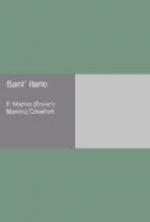The Rome of 1867 was not the Rome of 1870, as will perhaps be understood hereafter. With the exception of a few turbulent spirits, the city contained no revolutionary element, and very few who sympathised with the ideas of Italian Unification.
But without going any further into political considerations for the present, let us follow Anastase Gouache and his fifteen hundred comrades who marched out of the Porta Pia before dawn on the third of November. The battle that followed merits some attention as having been the turning-point of a stirring time, and also as having produced certain important results in the life of the French artist, which again reacted in some measure upon the family history of the Saracinesca.
Monte Rotondo itself is sixteen miles from Rome, but Mentana, which on that day was the outpost of the Garibaldians and became the scene of their defeat, is two miles nearer to the city. Most people who have ridden much in the Campagna know the road which branches to the left about five miles beyond the Ponte Nomentano. There is perhaps no more desolate and bleak part of the undulating waste of land that surrounds the city on all sides. The way is good as far as the turning, but after that it is little better than a country lane, and in rainy weather is heavy and sometimes almost impassable. As the rider approaches Mentana the road sinks between low hills and wooded knolls that dominate it on both sides, affording excellent positions from which an enemy might harass and even destroy an advancing force. Gradually the country becomes more broken until Mentana itself appears in view, a formidable barrier rising upon the direct line to Monte Rotondo. On all sides are irregular hillocks, groups of trees growing upon little elevations, solid stone walls surrounding scattered farmhouses and cattle-yards, every one of which could be made a strong defensive post. Mentana, too, possesses an ancient castle of some strength, and has walls of its own like most of the old towns in the Campagna, insignificant perhaps, if compared with modern fortifications, but well able to resist for many hours the fire of light field-guns.




